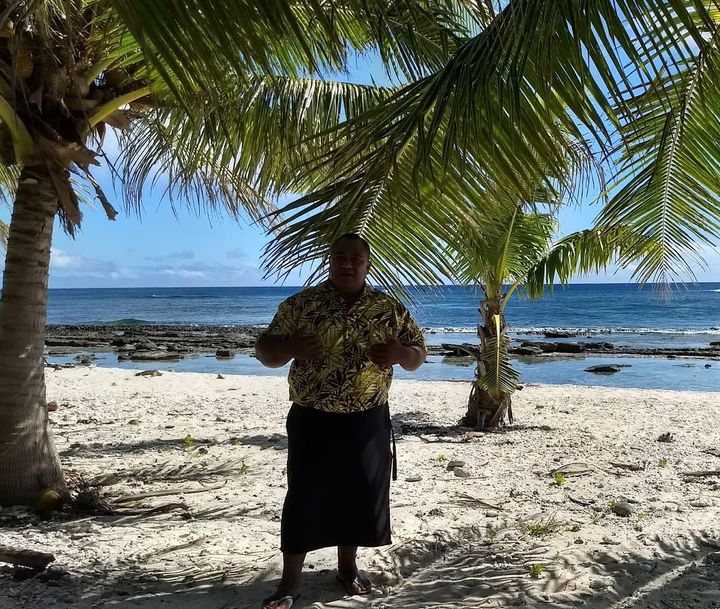
Vast expanse of exposed coral in the village of Siumu as seen in July this year - unprecedented exposure.
The Chiefs of Falealupo village, on the island of Savaii noticed a disturbing trend in the last ten years in their lagoon. The presence of crown of thorns have increased in alarming numbers. “It is impossible to fish here now. They have ruined the coral and now what was previously a productive reef, has been rendered useless by them,” Chief Aeau Mareko Lamositele.
According to them, their families used to be able to rely on fish from the lagoon in front of their village. “Now we have to venture further out, we have to fish for longer to get anything back,” Aeau said.
The people of Falealupo are dependent on the ocean for their daily sustanence and for their livelihoods. Through susbsistence fishing activities they are able to feed their families and sell any surplus for other family needs.
“It’s actually quite new, we haven’t ever experienced this, even into adulthood we were always able to fish here without any problems, and always return with plenty for the family,” Aeau said.
Crown of Thorns
The decline in fisheries and habitat health on the reefs of Falealupo have been attributed to a variety of factors, with one of them being an influx in the number of crown of thorns.
The crown of thorns has been a growing problem in Samoa. Scientists have found that rising sea temperatures increase the survival rate of the coral-eating crown-of-thorn starfish. Reports from the Australian Institute of Marine Science found that a 2-degree increase in temperature improved their likely survival rate by 240 per cent, or more than tripling it.
“Warmer sea temperatures were found in this study to enhance [starfish] survival along with other, cumulative pressures on the reef,” Sven Uthicke, the report’s lead author and AIMS scientist told the media recently. The Chiefs of Falealupo have made active steps towards restoring the health of their coastal ecosystems.

Chief Aeau lamenting on decline in coral health on reef behind him in his village.
Chief Aeau lamenting the decline in coral health on the reefs behind him in his village of Falealupo on Savaii Island, Samoa.
“We have extracted the COTs manually, but there are too many and they are too persistent for us to do it on our own,” Aeau said. The Chiefs have sought assistance from the Ministry of Natural Resources and Environment, and among them applied for a grant through the Small Grants Programme by the Global Environment Facility to target the Crown of thorns and restore their livelihoods from the oceans.
Fish Kills
Last year, Lice Movono-Rova of Newswire Fiji reported thousands of dead fish washed up on the shores of Coral Coast in Fiji. The pictures taken by Victor Bonito, a marine ecologist in Fiji show a beach scattered with dead fish. Similar reports were also received from Vanuatu where unprecedented high temperatures have led to fish kills.

Fish kills last year in Vanuatu
Bonito, a marine ecologist for Reef Explorer Fiji attributed the fish kill to high temperatures. “This is the worst thermal (heat) stress event I’ve witnessed on Coral Coast reefs during the 10 years I’ve lived here,” he said. Bonito who has been monitoring the water temperature said Reef Explorer Fiji has equipment in the water to measure water temperature, and confirms 5 degrees Celsius higher than normal in the area. He said the water has been peaking around 35, 35 degrees out on the reef flats with sea temperature is around 30 degrees.
In Vanuatu, the Vanuatu Daily Post reported hundreds of dead reef fish that included octopuses and crabs were found floating in the water and washed up in three locations across the islands.
The Department of Fisheries for Vanuatu on-site assessment registered a water surface temperature of 32 degrees Celcius during high tide which according to local Fisheries Officer Rocky Kaku, “would be much hotter during low tide.”
The National Oceanic and Atmospheric Administration (NOAA) recently published high sea surface temp anomalies (SSTA) across the Pacific including one in Fiji another high SSTA near Solomon’s causing the tropical depression currently active in the area.
Coral Bleaching
Coral bleaching has had severe impacts on the reefs of the Pacific. Scientists have noted that the Pacific region experiences larger than normal bleaching events - with notable impacts in the National Park of American Samoa in 1994, 2002, and 2003. As climate change continues, bleaching will become more common, and the overall health of coral reefs will decline. According to Scientists, much of the carbon dioxide that enters the atmosphere dissolves into the ocean. In fact, the oceans have absorbed about 1/3 of the carbon dioxide produced from human activities since 1800 and about 1/2 of the carbon dioxide produced by burning fossil fuels. As carbon dioxide in the ocean increases the ocean becomes more acidic, thus the term ocean acidification. With ocean acidification, corals cannot absorb the calcium carbonate they need to maintain their skeletons and the stony skeletons that support corals and reefs will dissolve.
This has been observed on the coasts of many Pacific communities and have impacted their abilities to benefit from their regular source of food and income.
These are just three of the many impacts of oceans and climate change on the livelihoods of Pacific people. The impact on subsistence activities, sustainable livelihoods, fisheries resources and tourism will be felt by the people of the Pacific for many years to come.
So yes, climate change and cities is an important focus, but let us not forget the direct impacts on community livelihoods on small island developing states. At the very end of the day, our collective emissions in the Pacific islands account for only 0.03% of emissions worldwide while cities contribute to 70% of emissions, so yes focus on the problem, but let’s also direct action and solutions to the involuntary victims of the actions of your cities.
*Taking place between 18-24 September in New York City, Climate Week NYC will be a key international summit to drive climate action forward around the world. This week I will write a story a day about the realities of climate change in the Pacific from an island perspective. Follow the stories at #cwnycpacific #CWNYC
